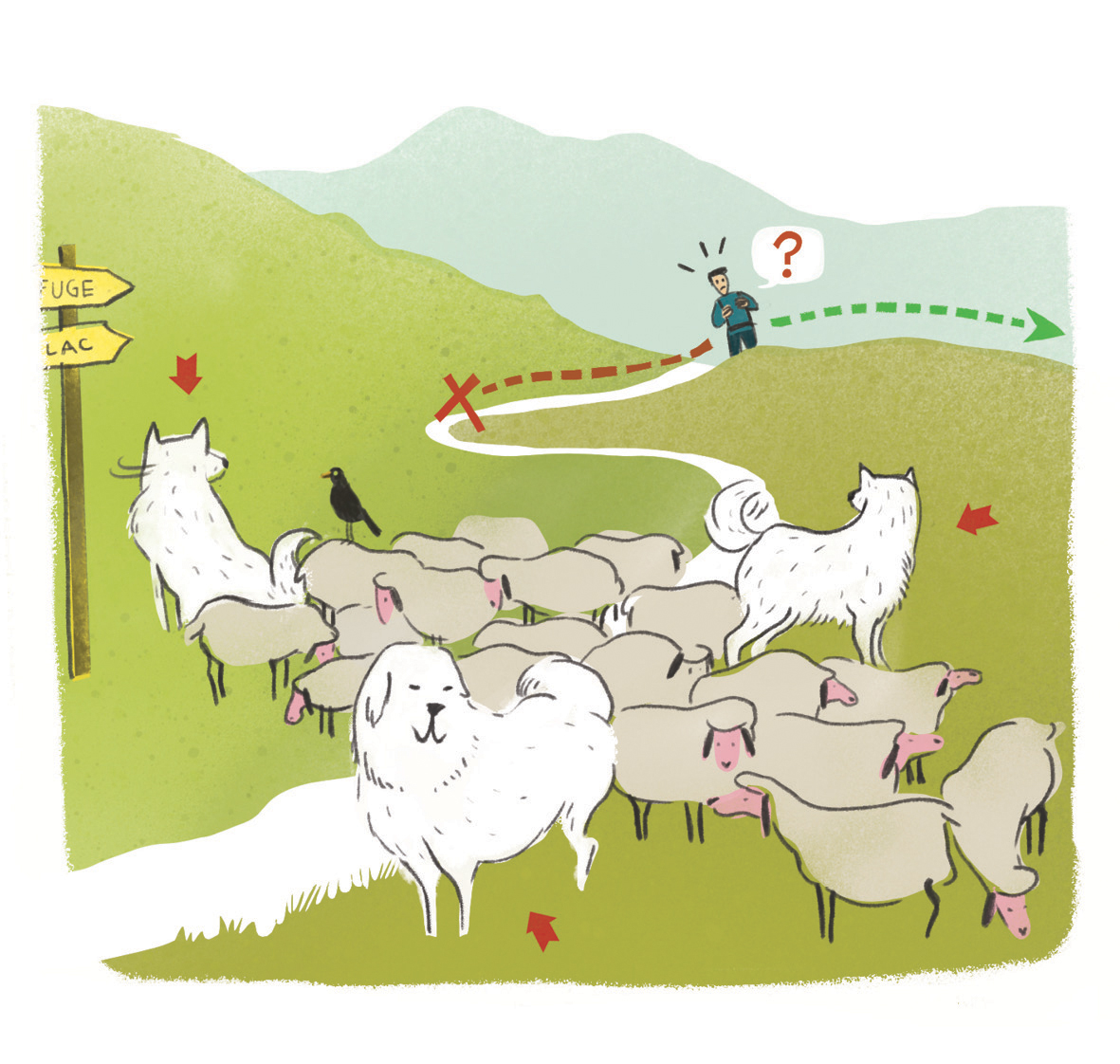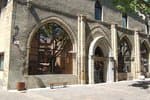5. Réallon - Embrun (TSP Gravel)
8 points of interest
 Know-how
Know-howRetaining walls
The retaining walls are made of dry stone. They are called restanques in Provence. In steep areas, they can be used to create farmed terraces by retaining the soil. At the time, their construction enabled generations of farmers to make a living from their land, which became fertile and arable. Today, many researchers and craftsmen are trying to bring back this age-old technique. Fauna
FaunaCommon Rock Thrush
The Common Rock Thrush likes sunny rocks. It only visits us in April until the end of August to nest either on the ground, or in a rock cavity. Orange breast, blue head, white rump, its song consists of sweet, clear melodious stanzas.
 Fauna
FaunaBlack Redstart
Mr. Black Redstart sports a grey skullcap and white marking on his wings, a black tail and rump. Originally a mountain bird, it has adapted to other environments, as long as there is a rocky atmosphere. Which is the case here, on the slope of the Roche Méanne. The Black Redstart is a common bird, bright and very lively: it constantly hunts insects in flight and on the ground. Often perched up high on a wall or a rock, it makes brief cries of alarm while bending its legs. Its chatty song, punctuated with sounds of « paper rustling » is characteristic. Partially migratory, it spends winter in the bottom of the valleys.
 History
HistoryAbandoned farms
Numerous abandoned farms can be seen. Some are no longer visible today because they have been overrun by vegetation. They were abandoned during the significant agricultural decline seen in the region during the nineteenth and early twentieth century, commonly called the "rural exodus" This altered the landscape significantly, with vegetation taking over in the abandoned fields and around ruined buildings. It is easy to imagine the harsh living conditions endured here by the peasants. History
HistoryRetaining walls
In the very steep areas of the mountains, growing conditions were difficult. In order to alleviate the difficulty of cultivating steeply sloping ground, dry stone retaining walls were built. In Provence, they are called restanques. These had the effect of retaining the earth and levelling out the ground, making it possible to grow crops. This is known as terrace cultivation. Panorama
PanoramaVantage point overlooking the Lac de Serre-Ponçon
This vantage point from the Pra Marin wood offers a sweeping view over the Lac de Serre-Ponçon. To the far left, the bridge of Savines-le-Lac and the Pic Morgon can be seen; to the right the view extends almost as far as the dam downstream from Sauze-du-Lac. In clear weather you can see in the background the La Blanche mountain range and the L'Estrop massif, in Alpes-de-Haute-Provence. On the right-hand shore of the lake stands the hamlet of Chèrines, together with the ski resort of Réallon at the foot of the Aiguilles de Chabrières. Fauna
FaunaChaffinch
The common chaffinch can easily be recognised by its double white wing stripe. It is the most common and widespread of the three species of chaffinches. Territorial during the breeding season, it gathers into large flocks to feed in winter. From the coast to the alpine zone, a year-round resident in the mountains, it is demanding, although it has a preference for open and cool forests. It is usually a seed-eater, it becomes an insectivore during the breeding season.
 Flora
FloraThe larch
The king of mountain trees in the Southern Alps, the larch is the only conifer to drop its needles in winter. In spring, its cones are a characteristic dark purple. The larch is one of the few European tree species that is imputrescible, that is to say, it does not rot. This is why, despite the fact that it twists as it dries out, it is widely use in frameworks, drinking troughs and other water holding vessels in the mountain villages. Incapable of germinating in its own undergrowth, it needs natural openings such as avalanche corridors for the young shoots to develop. It is found at altitudes in excess of 2,200 metres, adopting dwarf forms in these "combat" zones. The larch tree growing at this point on the trail is several hundred years old.
Description
2) At the road, turn right and then left to stay on the GR. Cross the Villard bridge to the right and head along the right bank. At "Côte Garcine", turn left towards the stream and ascend to Réallon. At the road, cross the village to the right.
3) After the Réallon village exit sign, leave the D41, take the left-hand track and then the first right onto the GR signposted path.
4) In the hamlet of Méans (Charrière des Touisses), turn left onto the small road towards Puy-Sanières Embrun (GR50). At the track, turn left. At the Reyssas stream, push the bike for 100m (steep, stony section)
5) At the chemin de la Baume, take the carriageway to the right. At the bend in the DFCI G1 track, turn left and stay on the main track to reach the "Porte de la Forêt" via the Lookout of La Para. (DFCI G1)
6) At the Porte de la Forêt car park, turn left onto the route forestière des Fontainiers. At the Route forestière du Bosquet, keep right (DFCI track G82).
7) Before the steep climb, take the path on the right towards Châteauroux 9 km. /!\ Quite a steep descent. Turn right at the path under the larches. Stay on the main road until you reach the hairpin /!\ watch your speed. Return journey possible as far as Châteauroux les Alpes (where accommodation is available) by turning left (follow route no. 53)
8) /!\ watch your speed: at the hairpin turn right and take 2 left turns on the less steep options. Then turn right at the edge of the wood onto the path on the right, which is carpeted with pine needles. (/!\ Several short sections with roots and stones).
9) After the houses, continue to the right on the less visible flat track. Above Les Barthelons, descend to the left, then take the first right onto the road. After the hamlet, turn left towards Embrun centre.
10) /!\ Slow down and turn left onto Chemin du Pigeonnier. /!\ Fast descent with waterways. At the end of the Chemin du Pigeonnier, turn left down the road to Embrun. Stay on the main road. Cross the railway line and take the 1st turning on the left to reach the SNCF station.
- Departure : Les Gourniers, Réallon
- Arrival : Embrun
- Towns crossed : Réallon, Puy-Saint-Eusèbe, Puy-Sanières, Embrun, and Châteauroux-les-Alpes
Altimetric profile
Recommandations
 In mountain pastures, protection dogs are there to protect the herds from predators (wolves, etc.).
In mountain pastures, protection dogs are there to protect the herds from predators (wolves, etc.).
When I hike I adapt my behavior by going around the herd and pausing for the dog to identify me.
Find out more about the actions to adopt with the article "Protection dogs: a context and actions to adopt".
Tell us about your meeting by answering this survey.
Information desks
Tourist office Réallon Station
Pra Prunier, 05160 Réallon
July and August : Monday to Friday : 9.00 -13.00 and Saturday 13.00 - 17.00
From mid-December to March : Monday to Sunday :9.00 - 12.30 & 14.00 - 17.00
Tourist office Embrun
Place Général Dosse - BP 49, 05202 Embrun
October to march : Monday to Saturday, 9.00 - 12.30 & 13.30 - 17.00.
April, may, june & september : Monday to Saturday, 9.00 - 12.30 & 14.30 - 18.00
July and August : Monday to Saturday, 9.00 - 19.00. Sundays, 10.00 - 12.30 & 16.00 - 19.00
On French national holidays (except 14th of July and 15th of August) : 9am to 1pm. Closed on the 1st of January, 1st of May, 25th December and 11th November
Closed on Thursdays outside French holidays’ periods
Transport
Bus : Valserres, La Bâtie Neuve, Chorges, Puy Saint Eusèbe, Puy Sanières, Embrun Baratier, Les Orres, Remollon, Theus, Espinasse
Marseille-Briançon : (LER29)
Marseille, Nice : Lignes Express Régionales (LER) +33 (0)809 400 415
Grenoble : Transisère +33 (0)4 26 16 38 38
Gap-Barcelonnette (LER535)
Carpooling area : Rond point des Orres - 05200 Baratier
Plane:
Marseille Provence Airport (188km) - +33 (0)820 811 414
Grenoble Alpes Isère Airport (158km) - +33 (0)4 76 65 48 48
Lyon Saint Exupéry Airport - (203km) +33 (0)826 800 826
Turin Caselle Airport - (178km) + 39 011 567 63 86
Access and parking
From Marseille, Montpellier A51 to La Saulce, continue towards Tallard (D942) and Briançon (RN 94).
More information
Source

Report a problem or an error
If you have found an error on this page or if you have noticed any problems during your hike, please report them to us here:

